10 bizarre phenomena that lit up the sky (and their scientific explanations)
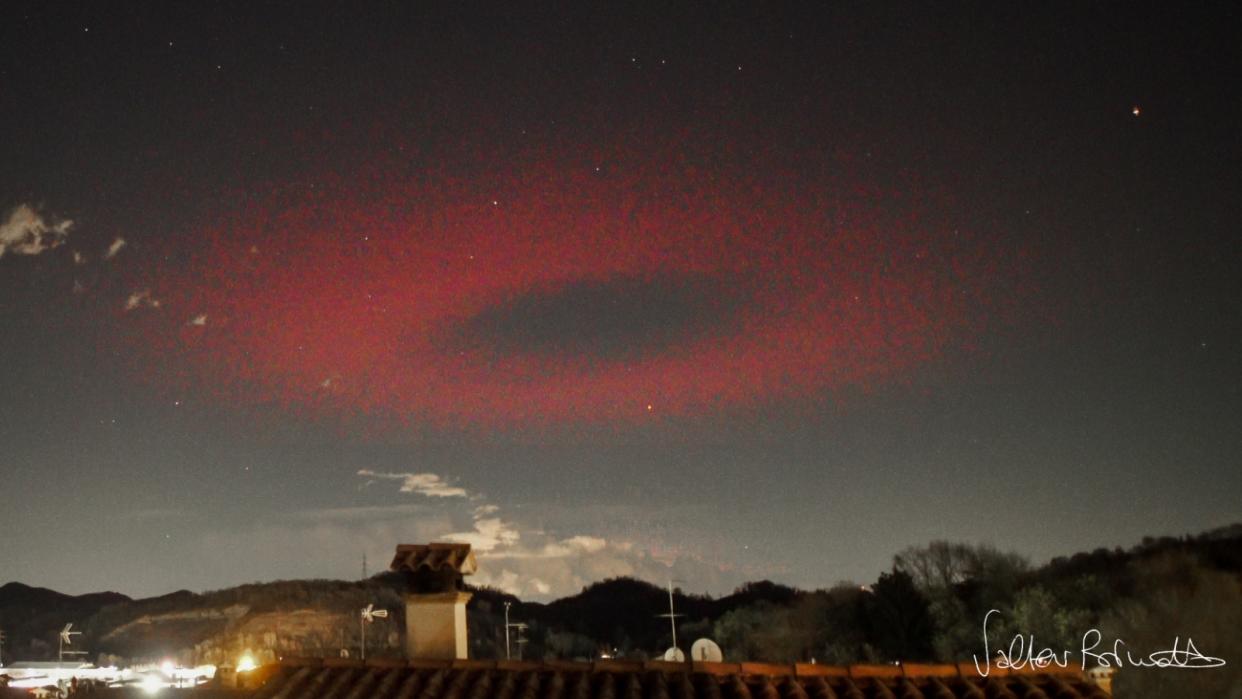
Weird lights appear in the sky way more often than most people realize. Often, photos of these bizarre light shows come with wild speculation about what caused them, from aliens to secret military weapons.
But unfortunately for conspiracy theorists, there is always a more Earthly scientific explanation for these luminous displays. From UFO-like rings to blood-red arcs, here are 10 bizarre atmospheric light shows with a surprisingly simple explanation.
Eerie UFO-like ring

This bizarre disk of red light appeared to briefly flash above the town of Possagno in northern Italy, hanging in the sky for just a few milliseconds before abruptly vanishing.
The fluorescent frisbee is known as an "emission of light and very low-frequency perturbations due to electromagnetic pulse sources," or elve It's an atmospheric disturbance created when lightning produces an electromagnetic pulse that hits Earth's ionosphere — the ionized part of the upper atmosphere that stretches between 50 and 400 miles (80 and 650 kilometers) above the ground. The red color is given off by excited nitrogen atoms in the ionosphere.
This luminous halo appeared during an intense thunderstorm around 175 miles (280 km) southeast of Possagno. But forced perspective made the massive ring, which had a diameter of around 225 miles (360 km), seemingly hang above the town.
Light arcs and halos
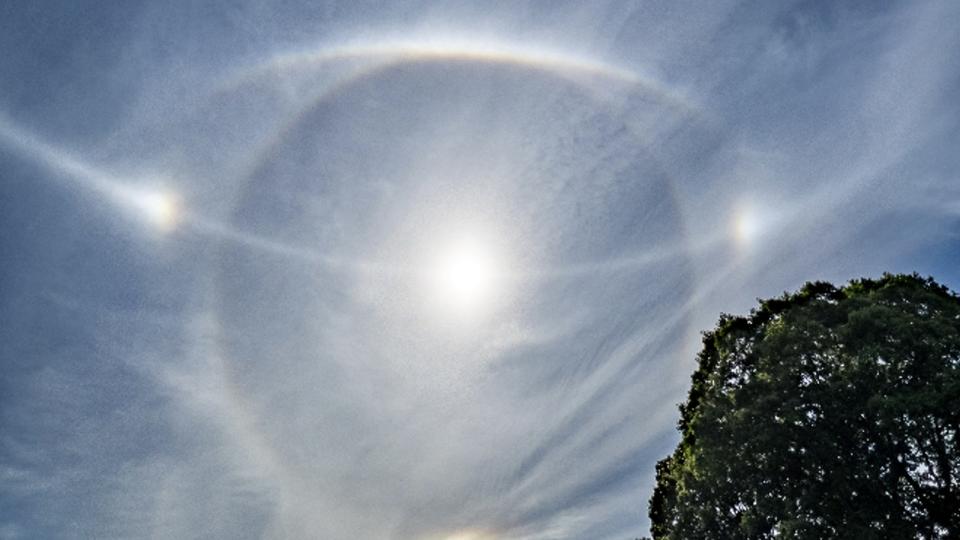
This photo, which was captured by an astronomer at Queen's University Belfast in Northern Ireland, shows a spectacular set of luminous arcs and halos shining around the sun.
Ethereal lights like these are created by sunlight shining through millions of tiny, perfectly positioned ice crystals in the upper atmosphere. The miniature hexagonal crystals refract light similarly to a prism, and when strong winds orient them in the same direction, the light they warp combines to produce lines of light.
The image shows at least three different optical phenomena: a 22-degree halo, which is the large circle surrounding the sun; a pair of "sundogs" — the bright points on each side of the 22-degree halo; and a complete parhelic circle — the line that bisects the circle — which is the rarest of this type of phenomenon. The image may also include features of a circumscribed halo and a supralateral arc, which form the "eyelids" above and below the 22-degree halo.
Individually, all these phenomena can be relatively common, but seeing them all together at once is extremely rare.
Bizarre blue blobs

An astronaut on board the International Space Station (ISS) snapped this image of two bizarre blue blobs of light glimmering in our planet's atmosphere. Intriguingly, the two blobs are completely unrelated to one another and just happened to occur at the same time.
The light blob at the bottom of the image,is a massive lightning strike that occurred next to a large, circular gap in the top of the clouds. This caused the lightning to illuminate the surrounding walls of the cloudy caldera-like structure, creating a striking luminous ring.
The blue blob in the top right of the image is the result of warped light from the moon. The moon's orientation in relation to the ISS meant the light it reflected back from the sun passed through the planet's atmosphere, transforming it into a bright blue blob with a fuzzy halo.
Ethereal whirlpool of light
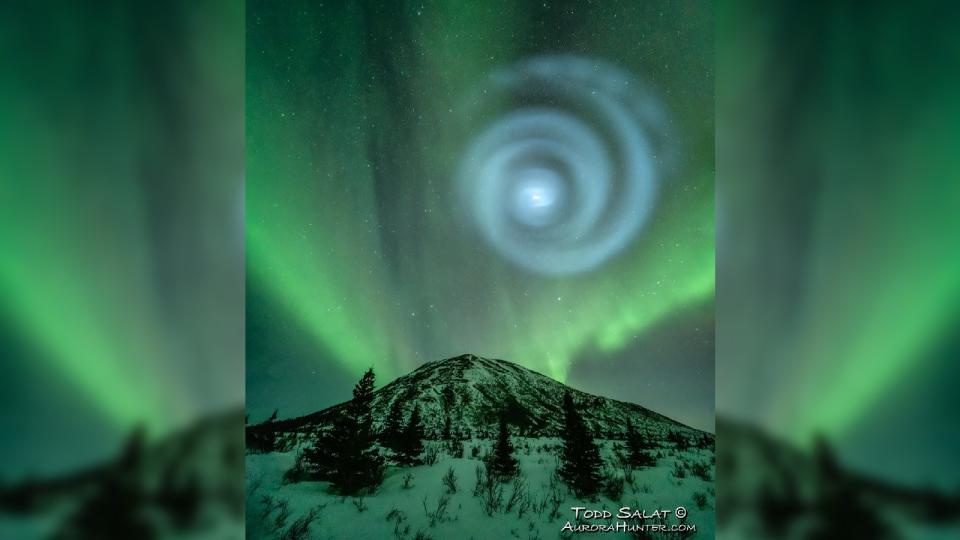
This ethereal whirlpool of blue light appeared in the night sky above Alaska, briefly stealing the limelight from a strong auroral display. But the bizarre, spiral-shaped object had nothing to do with the dancing polar lights.
The luminous spiral was made from frozen rocket fuel that was ejected by the fast-spinning, detached second stage of one of SpaceX's Falcon 9 rockets. Due to its high altitude, the frozen fuel reflected sunlight back to Earth, making it stand out in the night sky. Lights like these can last for several minutes before the frozen fuel crystals disperse.
A similar spiral was also filmed forming and then disappearing in the night sky above Hawaii. Astronomers have nicknamed the swirling light "SpaceX spirals" and believe they will become more common as the number of SpaceX launches increases.
Blood-red arc
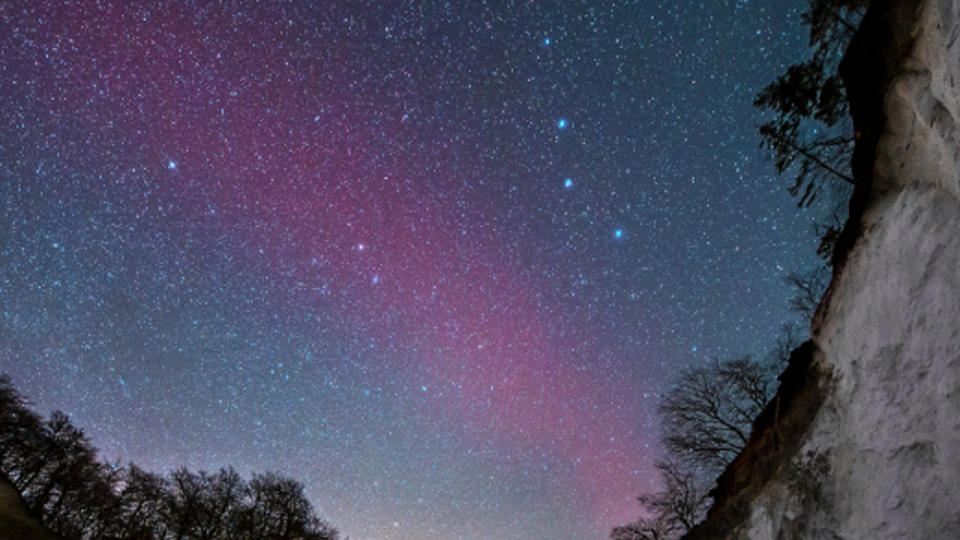
A bright red streak of light appeared in the sky above parts of Scandinavia after a powerful solar storm slammed into Earth. But the bright red band was not an aurora — it was something much rarer.
The unusual phenomenon is known as a stable auroral red arc (SAR) — but despite the name, it is neither an aurora nor particularly stable. Unlike auroras, which appear when solar radiation excites gas molecules in the upper atmosphere, SARs form when atmospheric gas is superheated by Earth's ring current system — a massive loop of electric current that surrounds our planet. Both phenomena become more likely after solar storms weaken Earth's magnetosphere.
For unknown reasons, only oxygen is heated up during a SAR, which means these phenomena always emit the same shade of red.
Rainbow clouds
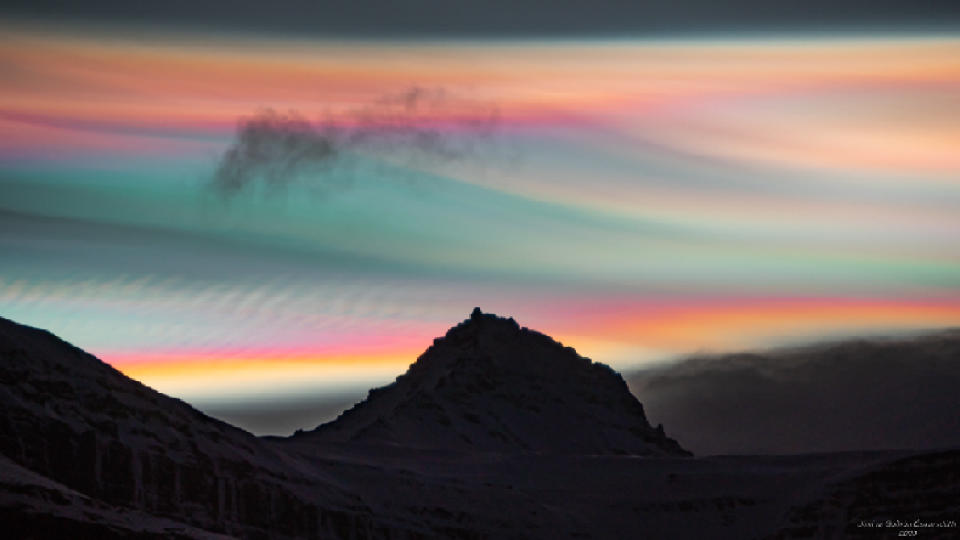
These multicolored clouds were spotted shining in the night sky above the Arctic.
The clouds, known as polar stratospheric clouds (PSCs), only form in the stratosphere — the second layer of Earth's atmosphere — at temperatures below minus 114 degrees Fahrenheit (minus 81 degrees Celsius). Normally, the stratosphere is too dry for clouds to form, but at extremely low temperatures, widely spaced water molecules begin to coalesce into tiny ice crystals that become clouds.
As sunlight shines through these crystal clouds, it gets scattered, creating multiple different wavelengths of light, which gives the clouds their rainbow colors. Due to the extreme altitude of the clouds, sunlight can hit the crystals and scatter above an observer even if the sun is beyond the horizon, which is when these clouds appear brightest.
Bright green laser lines
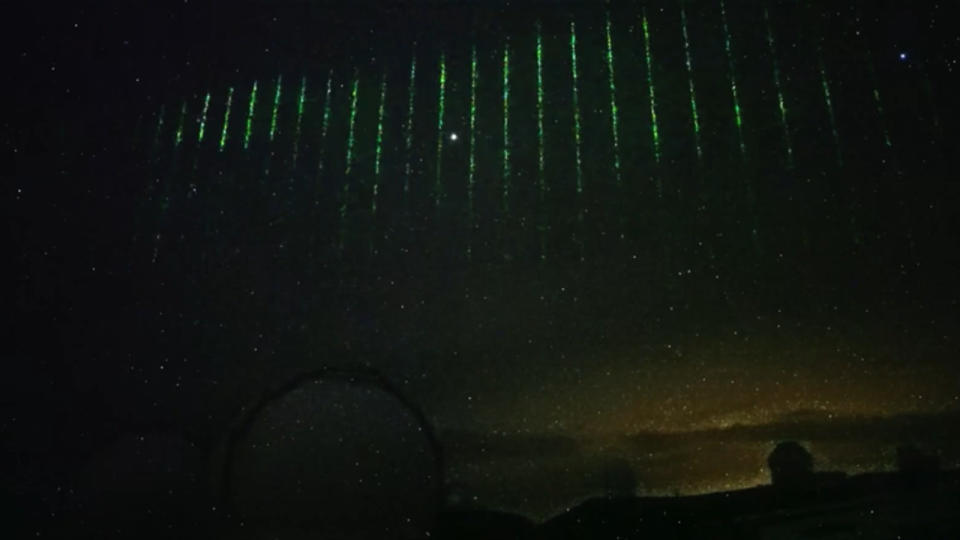
This image, which was captured by a telescope on Hawaii's tallest peak, Mauna Kea, shows bright green laser lines flashing across the night sky.
The lines, which appeared one after the other, only lasted for around a second. But they inspired online comparisons with "digital rain," or the lines of green computer code that fall vertically down the screen during the "Matrix" movies.
But these lines aren't evidence we are living in the matrix. Instead, they came from lasers fired from NASA's ICESat-2 satellite, which measures the amount of ice in Earth's cryosphere — the part of Earth covered by solid precipitation, including snow, sea ice, lake and river ice, icebergs, glaciers, ice sheets and ice shelves.
Stunning STEVE
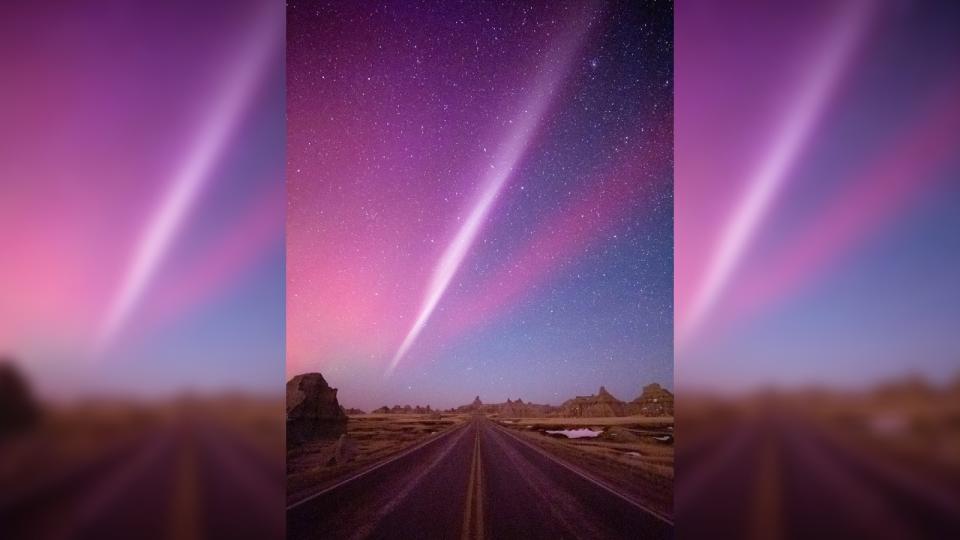
This bizarre, aurora-like streak of light, known as STEVE, was spotted across several U.S. states in the wake of a major solar storm in early 2023.
STEVE, or a "strong thermal emission velocity enhancement," is a rare phenomenon that creates a solid ribbon of light that hangs in the air for up to an hour. The ribbon is created by a river of hot plasma, or ionized gas, that breaks through Earth's weakened magnetosphere during solar storms. The flow of plasma is uniform and constant, which means the same gas remains excited and continuously gives off the same light.
STEVE can occur much further away from Earth's poles than auroras tend to appear, although scientists are still unsure why.
Shining rainbow rings
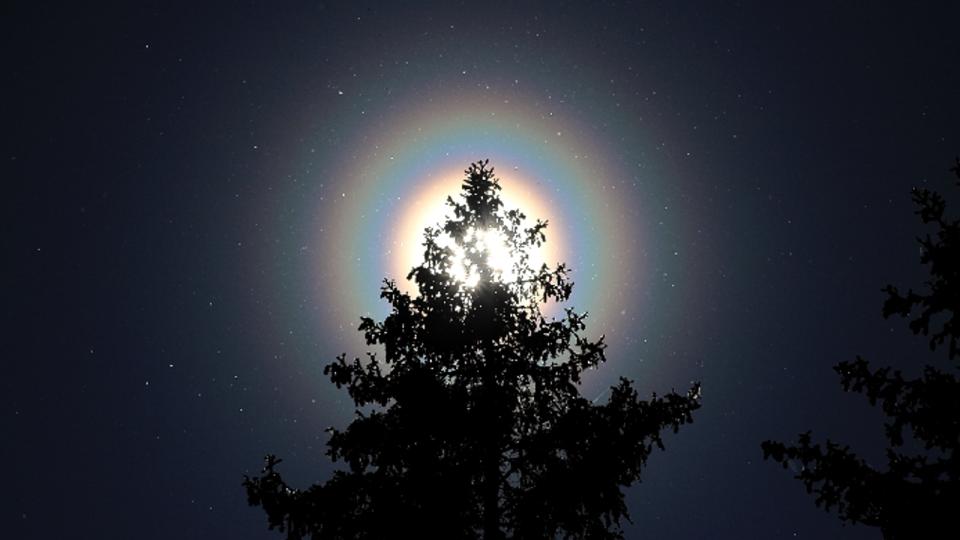
Something was in the air when this image of concentric rainbow-colored rings was snapped in Finland. And it turns out that something was pollen.
Multicolored rings such as these, known as "pollen coronas," form when sunlight scatters off thousands of pollen grains in the air. This creates a diffraction pattern, in which individual wavelengths of light cancel each other out and only allow certain colors to be seen by the observer. Individual grains are also illuminated and appear as bright spots in the image.
The pollen in the image comes from pine trees (Pinus sylvestris), which have air sacs that help them float (as well as making them look like Mickey Mouse ears).
Pollen coronas only appear when pollen concentrations are very high and can only be clearly seen when the sun or full moon is partially obscured.
Bleeding sky
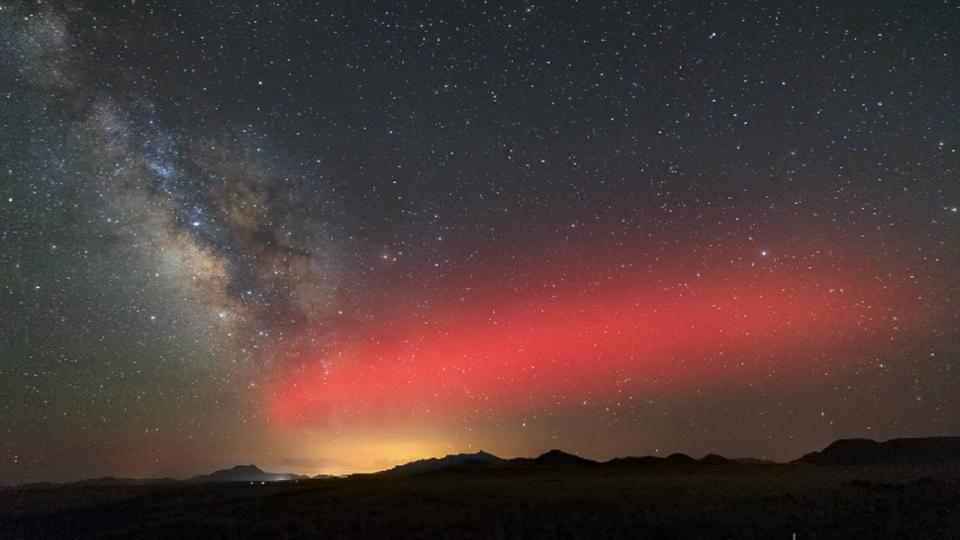
A blood-red streak of light was left behind in the sky above Arizona after one of SpaceX's Falcon 9 rockets punched a hole in Earth's ionosphere.
"Ionospheric holes" are created when a rocket's second stage burns fuel between 125 and 185 miles (200 and 300 km) above Earth's surface. At this height, the carbon dioxide and water vapor from the rocket's exhaust cause ionized oxygen atoms to recombine or form back into diatomic oxygen molecules, creating a gap in the plasma. This also excites the molecules and causes them to emit energy in the form of light.
Scientists have known about ionospheric holes for a while, but they are becoming more common as the number of rocket launches increases. The holes pose no threat to people on the surface, and they naturally close up within a few hours as the recombined gases get re-ionized.
